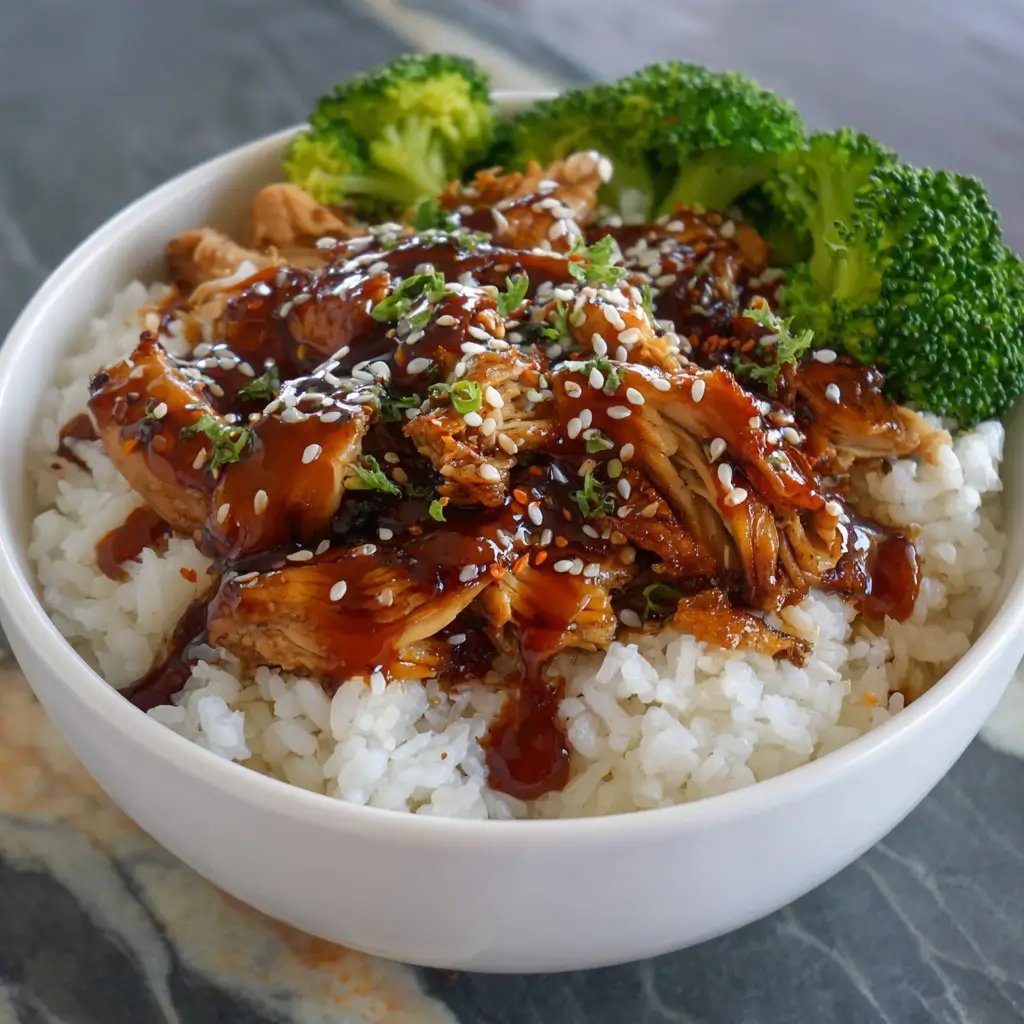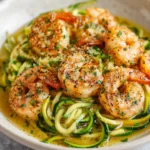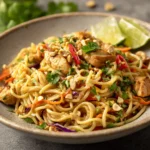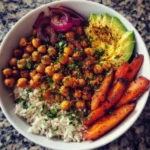Introduction
Sesame Teriyaki Chicken Rice Bowls are a delightful fusion of bold, savory, sweet, and umami-rich flavors that bring the essence of Asian-inspired cuisine straight to your kitchen. This wholesome, one-bowl meal combines tender, glazed chicken with fluffy rice, crisp vegetables, and a nutty sesame kick, making it a go-to choice for busy weeknights, meal prep, or an impressive yet simple dinner for guests. Packed with vibrant colors and textures, this dish balances comfort and nutrition in every bite. Whether you’re a seasoned home cook or just beginning your culinary journey, this recipe is approachable, customizable, and deeply satisfying.
The History
Teriyaki, as a cooking technique, originated in Japan centuries ago, where “teri” refers to the lustrous, glossy sheen created by the sugar in the sauce, and “yaki” means grilled or broiled. Traditionally, fish such as salmon or mackerel was marinated and then grilled with a glaze made from soy sauce, mirin, and sake. Over time, teriyaki evolved and became popular worldwide, especially in North America, where it adapted to local tastes—often using chicken, beef, or tofu. The addition of sesame oil and seeds reflects broader East and Southeast Asian influences, particularly from Chinese and Korean cuisines, which frequently use sesame for its rich, nutty flavor. Today, Sesame Teriyaki Chicken Rice Bowls represent a modern, globalized take on traditional teriyaki, combining Japanese technique with pan-Asian ingredients and American convenience, making it a staple in fusion restaurants and home kitchens alike.
Ingredients Breakdown
The magic of this dish lies in the harmony of its components. Each ingredient plays a vital role in building layers of flavor, texture, and nutrition:
- Chicken Breast or Thighs: Lean and protein-packed, boneless, skinless chicken breasts are commonly used, but thighs offer a juicier, more flavorful alternative due to their higher fat content.
- Soy Sauce: The base of the teriyaki sauce, providing saltiness and umami depth. For a lower-sodium option, use reduced-sodium soy sauce.
- Low-Sodium Chicken Broth: Adds moisture and richness to the sauce without overpowering saltiness.
- Honey or Brown Sugar: Natural sweeteners that balance the saltiness and help create the signature glossy glaze when caramelized.
- Rice Vinegar: Adds a subtle tang that brightens the sauce and cuts through the richness.
- Fresh Ginger and Garlic: Aromatics that infuse the sauce with warmth, spice, and complexity—essential for authentic flavor.
- Cornstarch: Used as a thickening agent to give the teriyaki sauce a velvety, clingy consistency.
- Sesame Oil: Adds a deep, nutty aroma and enhances the overall fragrance of the dish. Use toasted sesame oil for maximum flavor.
- Sesame Seeds (white and/or black): Provide visual contrast and a delightful crunch, reinforcing the sesame theme.
- Jasmine or Sushi Rice: Fragrant, slightly sticky rice varieties that hold the sauce well and complement the bold flavors.
- Vegetables: Commonly includes broccoli, bell peppers, carrots, snap peas, or bok choy—adds color, fiber, and nutrients.
- Green Onions: Chopped and used as garnish for freshness and mild onion flavor.
- Optional Additions: Pineapple chunks (for sweetness), chili flakes (for heat), or scallions and cilantro for herbal notes.
Step-by-Step Recipe
- Prepare the Rice: Rinse 1 cup of jasmine rice under cold water until the water runs clear. In a medium saucepan, combine the rice with 1¾ cups water. Bring to a boil, then reduce heat to low, cover, and simmer for 15–18 minutes, or until water is absorbed and rice is tender. Remove from heat and let it sit covered for 5 minutes. Fluff with a fork and set aside.
- Make the Teriyaki Sauce: In a small bowl, whisk together ½ cup low-sodium soy sauce, ¼ cup honey (or brown sugar), ¼ cup low-sodium chicken broth, 2 tablespoons rice vinegar, 1 tablespoon cornstarch, 1 tablespoon grated fresh ginger, 3 minced garlic cloves, and 1 teaspoon toasted sesame oil. Set aside.
- Cook the Chicken: Slice 1.5 lbs of boneless, skinless chicken breasts into thin strips or bite-sized pieces. Heat 1 tablespoon of neutral oil (like canola or avocado) in a large skillet or wok over medium-high heat. Add the chicken in a single layer and cook for 5–6 minutes per side, until golden brown and cooked through (internal temperature of 165°F). Remove chicken and set aside.
- Sauté the Vegetables: In the same skillet, add 1 tablespoon of sesame oil. Toss in 2 cups of chopped broccoli florets, 1 sliced red bell pepper, and 1 shredded carrot. Stir-fry for 4–5 minutes until crisp-tender. Add ¼ cup of water, cover, and steam for 2 minutes if needed to soften.
- Simmer the Sauce: Return the chicken to the skillet with the vegetables. Pour the prepared teriyaki sauce over the mixture. Bring to a gentle simmer and cook for 3–5 minutes, stirring frequently, until the sauce thickens and coats everything evenly.
- Finish and Serve: Remove from heat. Stir in 1 tablespoon of additional toasted sesame oil for extra aroma. Garnish with sliced green onions and a generous sprinkle of white and black sesame seeds.
- Assemble the Bowls: Divide the cooked rice among serving bowls. Top with the sesame teriyaki chicken and vegetable mixture. Drizzle with extra sauce if desired, and serve immediately.
Tips
- Marinate the Chicken: For deeper flavor, marinate the chicken in half the teriyaki sauce for 30 minutes to 2 hours before cooking.
- Avoid Overcooking Chicken: Cut pieces uniformly to ensure even cooking. Overcooked chicken can become dry, so remove it promptly once it reaches 165°F.
- Thicken Sauce Properly: Make sure to whisk cornstarch thoroughly into the cold sauce before heating to prevent clumping. If the sauce is too thick, add a splash of broth; if too thin, mix ½ teaspoon cornstarch with 1 tablespoon water and stir in while simmering.
- Use Fresh Aromatics: Fresh ginger and garlic make a noticeable difference compared to powdered versions. Grate them finely for better distribution.
- Double the Sauce: Many people love extra sauce—consider making 1.5x the amount to have leftovers or for drizzling.
- Meal Prep Friendly: This dish stores well. Keep components separate in airtight containers for up to 4 days. Reheat in a skillet or microwave, adding a splash of water to refresh the sauce.
- High-Heat Cooking: To achieve a nice sear on the chicken, avoid overcrowding the pan. Cook in batches if necessary.
Variations and Customizations
This recipe is highly adaptable to suit dietary preferences, cultural twists, or pantry limitations:
- Protein Swaps: Replace chicken with salmon, shrimp, tofu, tempeh, or thinly sliced beef (like flank steak).
- Vegetarian/Vegan Version: Use firm tofu or edamame instead of chicken, substitute honey with maple syrup or agave, and ensure the soy sauce is vegan (no animal derivatives).
- Gluten-Free Option: Use tamari or a certified gluten-free soy sauce, and confirm all other ingredients (like broth) are gluten-free.
- Different Grains: Swap jasmine rice for brown rice, quinoa, cauliflower rice (for low-carb), or sushi rice for a stickier texture.
- Spicy Kick: Add sriracha, gochujang, or red pepper flakes to the sauce for heat lovers.
- Fruit Infusion: Stir in pineapple tidbits during the last minute of cooking for a sweet-tart tropical twist.
- Noodle Bowl Variation: Replace rice with soba, udon, or rice noodles for a different mouthfeel.
- Korean-Inspired: Add gochujang and a dash of pear juice to the sauce, top with kimchi and a fried egg.
- Mediterranean Fusion: Add olives, cucumber, and a tahini drizzle for a cross-cultural twist.
Health Considerations and Nutritional Value
A typical serving (one bowl with ¾ cup rice, 4 oz chicken, vegetables, and sauce) contains approximately:
- Calories: 450–550 kcal
- Protein: 30–35g (supports muscle repair and satiety)
- Carbohydrates: 50–60g (primarily from rice and natural sugars)
- Fat: 12–16g (mostly healthy unsaturated fats from sesame oil and chicken)
- Sodium: 800–1000mg (can be reduced by using low-sodium soy sauce and broth)
- Fiber: 4–6g (from vegetables and whole grains if using brown rice)
- Vitamins & Minerals: Rich in vitamin C (bell peppers, broccoli), vitamin A (carrots), B vitamins (chicken, rice), iron, and antioxidants from ginger and garlic.
Health Tips:
- For heart health, limit added sugar by reducing honey or using a sugar substitute like monk fruit.
- To support weight management, increase non-starchy vegetables and reduce rice portion size.
- Sesame seeds provide calcium, magnesium, and healthy fats, contributing to bone and cardiovascular health.
- Ginger has anti-inflammatory properties and may aid digestion.
- Balancing macronutrients makes this a well-rounded meal suitable for active individuals, families, and fitness enthusiasts.
Ingredients
- 1 cup jasmine rice
- 1¾ cups water
- 1.5 lbs boneless, skinless chicken breasts or thighs
- 2 tablespoons neutral oil (canola, avocado, or vegetable)
- 2 tablespoons toasted sesame oil, divided
- ½ cup low-sodium soy sauce
- ¼ cup honey (or packed brown sugar)
- ¼ cup low-sodium chicken broth
- 2 tablespoons rice vinegar
- 1 tablespoon cornstarch
- 1 tablespoon fresh ginger, grated
- 3 garlic cloves, minced
- 2 cups broccoli florets
- 1 red bell pepper, sliced
- 1 large carrot, julienned or shredded
- 3 green onions, sliced
- 2 tablespoons sesame seeds (white, black, or mixed)
Directions
- In a medium saucepan, rinse jasmine rice under cold water until water runs clear. Add rice and 1¾ cups water. Bring to a boil, then reduce heat to low, cover, and simmer for 15–18 minutes. Remove from heat and let stand, covered, for 5 minutes. Fluff with a fork and keep warm.
- While rice cooks, prepare the teriyaki sauce: In a bowl, whisk together soy sauce, honey, chicken broth, rice vinegar, cornstarch, grated ginger, minced garlic, and 1 tablespoon sesame oil. Set aside.
- Cut chicken into uniform, bite-sized pieces. Season lightly with salt and pepper.
- Heat 1 tablespoon neutral oil in a large skillet or wok over medium-high heat. Add chicken in a single layer and cook 5–6 minutes per side until golden and internal temperature reaches 165°F. Transfer to a plate and set aside.
- Add remaining 1 tablespoon sesame oil to the same skillet. Add broccoli, bell pepper, and carrot. Stir-fry for 4–5 minutes until crisp-tender. Add a splash of water if needed and cover briefly to steam.
- Return chicken to the skillet. Pour in the teriyaki sauce and stir to coat. Simmer for 3–5 minutes, stirring often, until sauce thickens and bubbles.
- Remove from heat. Stir in the extra 1 tablespoon toasted sesame oil for enhanced aroma.
- Divide rice among serving bowls. Top with the sesame teriyaki chicken and vegetables.
- Garnish with sliced green onions and a generous sprinkle of sesame seeds.
- Serve immediately, with extra sauce on the side if desired.
FAQ
Can I make this ahead of time?
Yes! Cook the components separately and store in airtight containers in the refrigerator for up to 4 days. Reheat in a skillet or microwave, adding a splash of water to loosen the sauce.
Can I freeze Sesame Teriyaki Chicken?
Yes, though the texture of the vegetables may soften upon thawing. Freeze in portioned containers for up to 3 months. Thaw overnight in the fridge and reheat gently.
Is this recipe gluten-free?
It can be! Use tamari or certified gluten-free soy sauce and verify all other ingredients are gluten-free.
What can I use instead of honey?
Maple syrup, agave nectar, or brown rice syrup work well as vegan alternatives. Adjust sweetness to taste.
How do I get a thicker teriyaki glaze?
Ensure you’re using cornstarch and simmering long enough. You can also reduce the sauce longer or add a cornstarch slurry (½ tsp cornstarch + 1 tbsp water) while cooking.
Can I use frozen vegetables?
Absolutely. Use a blend like stir-fry mix, but thaw and drain excess water first to prevent diluting the sauce.
What sides pair well with this bowl?
Consider miso soup, seaweed salad, pickled ginger, or a simple cucumber salad for a complete Asian-inspired meal.
Can I cook this in a slow cooker?
Yes. Combine chicken, sauce, and vegetables in the slow cooker and cook on low for 4–5 hours. Serve over freshly cooked rice.
Summary
Sesame Teriyaki Chicken Rice Bowls deliver a restaurant-quality meal at home with minimal effort—featuring juicy chicken glazed in a glossy, savory-sweet sauce over fluffy rice and crisp vegetables. Packed with flavor, nutrition, and endless customization options, it’s a versatile, family-friendly dish perfect for any night of the week.










